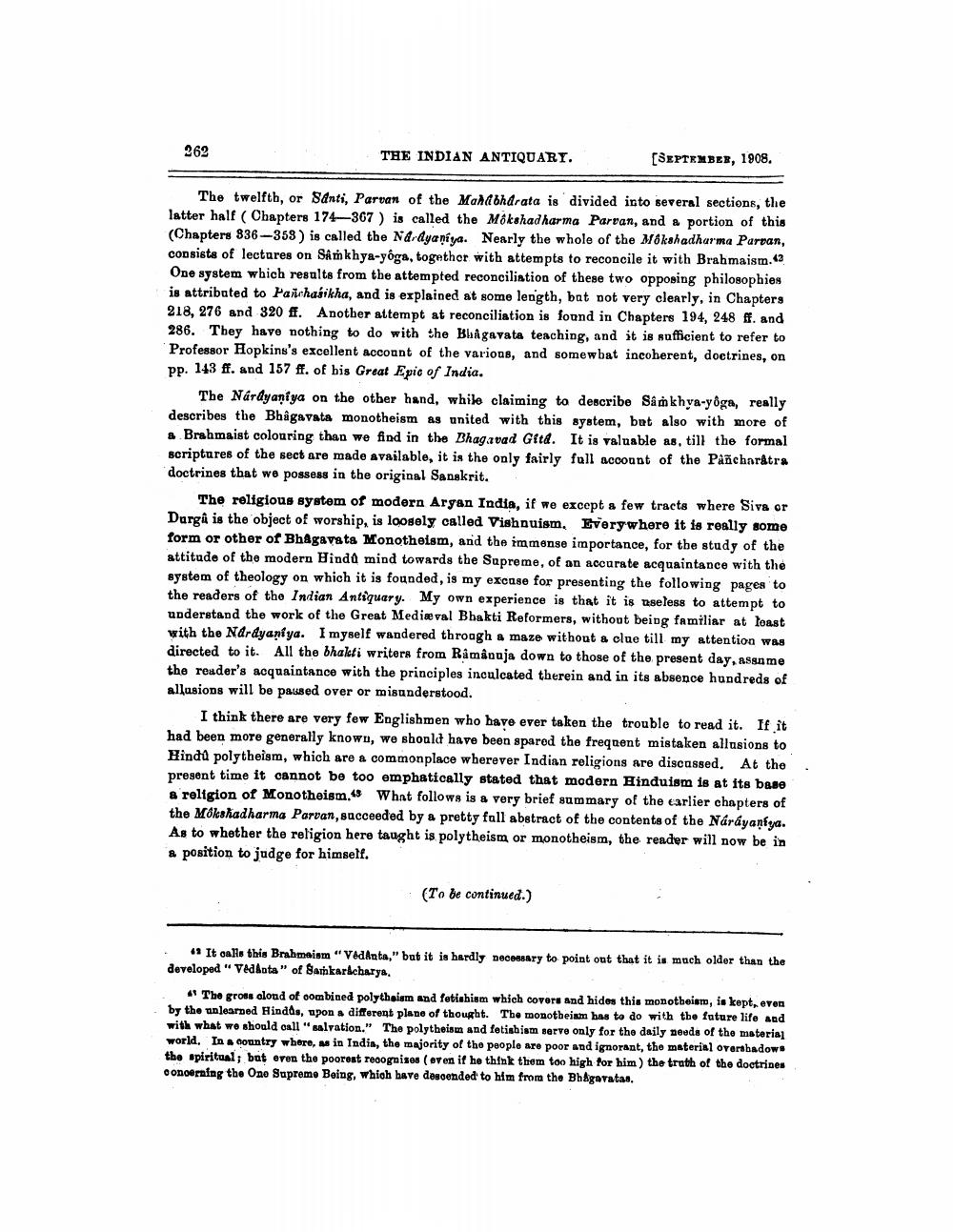________________
262
THE INDIAN ANTIQUARY.
[SEPTEMBER, 1908.
The twelfth, or Santi, Parvan of the Mahabharata is divided into several sections, the latter half (Chapters 174-367) is called the Mokshadharma Parvan, and a portion of this (Chapters 836-353) is called the Nadyaniya. Nearly the whole of the Mokshadharma Parvan, consists of lectures on Sâmkhya-yoga, together with attempts to reconcile it with Brahmaism.42 One system which results from the attempted reconciliation of these two opposing philosophies is attributed to Pañchasikha, and is explained at some length, but not very clearly, in Chapters 218, 276 and 320 ff. Another attempt at reconciliation is found in Chapters 194, 248 ff. and 286. They have nothing to do with the Bhagavata teaching, and it is sufficient to refer to Professor Hopkins's excellent account of the various, and somewhat incoherent, doctrines, on pp. 143 ff. and 157 ff. of his Great Epic of India.
The Nardyaniya on the other hand, while claiming to describe Sâm khya-yoga, really describes the Bhagavata monotheism as united with this system, but also with more of a Brahmaist colouring than we find in the Bhagavad Gitd. It is valuable as, till the formal scriptures of the sect are made available, it is the only fairly full account of the Pañcharâtra doctrines that we possess in the original Sanskrit.
The religious system of modern Aryan India, if we except a few tracts where Siva or Durga is the object of worship, is loosely called Vishnuism. Everywhere it is really some form or other of Bhagavata Monotheism, and the immense importance, for the study of the attitude of the modern Hindu mind towards the Supreme, of an accurate acquaintance with the system of theology on which it is founded, is my excuse for presenting the following pages to the readers of the Indian Antiquary. My own experience is that it is useless to attempt to understand the work of the Great Medieval Bhakti Reformers, without being familiar at least with the Narayaniya. I myself wandered through a maze without a clue till my attention was directed to it. All the bhakti writers from Râmânuja down to those of the present day, assume the reader's acquaintance with the principles inculcated therein and in its absence hundreds of allusions will be passed over or misunderstood.
I think there are very few Englishmen who have ever taken the trouble to read it. If it had been more generally known, we should have been spared the frequent mistaken allusions to Hindú polytheism, which are a commonplace wherever Indian religions are discussed. At the present time it cannot be too emphatically stated that modern Hinduism is at its base a religion of Monotheism. What follows is a very brief summary of the earlier chapters of the Mokshadharma Parvan, succeeded by a pretty full abstract of the contents of the Nárayaniya. As to whether the religion here taught is polytheism or monotheism, the reader will now be in a position to judge for himself.
(To be continued.)
42 It calls this Brahmaism "Vedanta," but it is hardly necessary to point out that it is much older than the developed "Vedanta" of Samkaracharya.
4 The gross cloud of combined polytheism and fetishism which covers and hides this monotheism, is kept, even by the unlearned Hindås, upon a different plane of thought. The monotheism has to do with the future life and with what we should call "salvation." The polytheism and fetishism serve only for the daily needs of the material world. In a country where, as in India, the majority of the people are poor and ignorant, the material overshadows the spiritual; but even the poorest recognises (even if he think them too high for him) the truth of the doctrines concerning the One Supreme Being, which have descended to him from the Bhagavatas.




